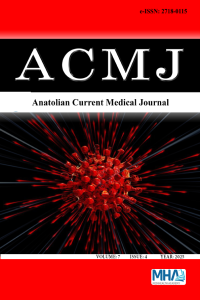Abstract
Aims: Surgical interventions for benign conditions are frequently performed in general surgery practice; however, the incidental detection of malignancies in these specimens represents a clinically significant and often overlooked issue. This study aimed to investigate the incidence, pathological characteristics, and follow-up status of incidental malignancies identified in routinely resected specimens, with a particular emphasis on the adequacy of postoperative notification and follow-up processes.
Methods: A retrospective cohort study was conducted on 2.590 surgical procedures—appendectomy, cholecystectomy, abdominal wall hernia repair, hemorrhoidectomy, and pilonidal sinus excision—performed between January 1, 2023, and January 1, 2024, at a tertiary care institution. Patients with preoperatively known or radiologically suspected malignancies were excluded. Pathological reports were reviewed for incidental malignant findings, and follow-up data were obtained via electronic health records and direct patient communication.
Results: Among the reviewed cases, ten incidental malignancies (0.39%) were identified: eight in appendectomy specimens, one in a cholecystectomy specimen, and one in a hernia sac. Remarkably, 30% of the affected patients were unaware of their pathological diagnosis until they were contacted by the researchers. Significant variability in specimen submission practices, especially in hernia and hemorrhoidectomy cases, may have contributed to underdiagnosis.
Conclusion: Although rare, incidental malignancies carry substantial prognostic implications if left unrecognized or inadequately managed. Routine pathological evaluation of all surgical specimens—regardless of presumed benignity—and the implementation of automated alert systems for critical pathology results are essential for timely diagnosis, appropriate referral, and improved patient outcomes.
References
- Sakata S, van den Heuvel B, Verhagen T, et al. The value of routine histopathological examination after haemorrhoidectomy in patients at low and high risk of anal squamous intraepithelial lesions and cancer. Colorectal Dis. 2025;27(3):e70056. doi:10.1111/codi.70056
- Navale P, Gonzalez RS, Vyas M. Incidental secondary findings in hemorrhoidectomy specimens: a 16-year experience from a single academic center. Hum Pathol. 2021;109:12-20. doi:10.1016/j.humpath. 2020.11.008
- Alarcón-Del Agua I, Ortega-Serrano J, Docobo-Durantez F, et al. Malignant degeneration in pilonidal disease. Cir Cir. 2011;79(4):346-350.
- Safadi MF, Degiannis K, Doll D. Pilonidal sinus disease carcinoma: survival and recurrence analysis. J Surg Oncol. 2023;128(4):569-575. doi: 10.1002/jso.27319
- Jones BA, Novis DA. Follow-up of abnormal gynecologic cytology: a College of American Pathologists Q-Probes study of 16132 cases from 306 laboratories. Arch Pathol Lab Med. 2000;124(5):665-671. doi:10. 5858/2000-124-0665-FUOAGC
- Van de Moortele M, De Hertogh G, Sagaert X, Van Cutsem E. Appendiceal cancer: a review of the literature. Acta Gastroenterol Belg. 2020;83(3):441-448.
- Bastiaenen VP, de Jonge SW, de Savornin Lohman EAJ, Kievit W, Bemelman WA. Routine histopathologic examination of the appendix after appendectomy for presumed appendicitis: Is it really necessary? A systematic review and meta-analysis. Surgery. 2020;168(2):305-312. doi: 10.1016/j.surg.2020.03.032
- Shwin M, Aziz A, Al-Azzawi W. Incidental finding of metastatic mesothelioma in an inguinal hernia sac: a case report. J Surg Case Rep. 2025;2025(2):rjaf099. doi:10.1093/jscr/rjaf099
- Kim MS, Choi DH, Lee NY, et al. Post-operative radiation therapy with or without chemotherapy for anal squamous cell carcinoma incidentally discovered after local excision: a propensity score matched analysis of retrospective multicenter study. Br J Radiol. 2020;93(1106):20190667. doi:10.1259/bjr.20190667
- Menon V, Kaur D, Bahl P, Jin J, Hill A. Is routine histopathological analysis of hemorrhoidectomy specimens necessary? A systematic review and meta-analysis. World J Surg. 2024;48(8):1981-1989. doi:10. 1002/wjs.12235
- Chan KKL, Cheung AN, Leung TYM, et al. 2024 Hong Kong College of Obstetricians and Gynaecologists guidelines for cervical cancer prevention and screening. Hong Kong Med J. 2024;30(6):488-497. doi:10. 12809/hkmj2411547
- Kole J, Fiester A. Incidental findings and the need for a revised informed consent process. AJR Am J Roentgenol. 2013;201(5):1064-1068. doi:10. 2214/AJR.13.11138
- Young WF Jr. Clinical practice: the incidentally discovered adrenal mass. N Engl J Med. 2007;356(6):601-610. doi:10.1056/NEJMcp065470
- Singal AG, Kurtzman KN, Thompson MJ. Leveraging multi-cancer blood tests to improve diagnostic efficiency for patients with nonspecific signs and symptoms. Future Oncol. 2024;20(34):2603-2607. doi:10.1080/14796694.2024.2388505
- Scheel BI, Holtedahl K. Symptoms, signs, and tests: the general practitioner's comprehensive approach towards a cancer diagnosis. Scand J Prim Health Care. 2015;33(3):170-177. doi:10.3109/02813432.2015. 1067512
- Stenman E, Palmér K, Rydén S, Sävblom C, Ji J, Sundquist J. Diagnostic center for primary care patients with nonspecific symptoms and suspected cancer: compliance to workflow and accuracy of tests and examinations. Scand J Prim Health Care. 2021;39(2):148-156. doi:10.1080/02813432. 2021.1913892
- Siewert B, Sosna J, McNamara A, Raptopoulos V, Kruskal JB. Missed lesions at abdominal oncologic CT: lessons learned from quality assurance. Radiographics. 2008;28(3):623-638. doi:10.1148/rg.283075188
- Cline Michael R, Cherry-Bukoweiz J, Machado-Aranda D, Chong Suzanne T. Diagnostic limits, blind spots, and pitfalls in CT imaging of blunt abdominal trauma. Contemporary Diagn Radiol. 2016;39(22):1-6. doi:10.1097/01.CDR.0000503353.20435.53
Abstract
Aims: Surgical interventions for benign conditions are frequently performed in general surgery practice; however, the incidental detection of malignancies in these specimens represents a clinically significant and often overlooked issue. This study aimed to investigate the incidence, pathological characteristics, and follow-up status of incidental malignancies identified in routinely resected specimens, with a particular emphasis on the adequacy of postoperative notification and follow-up processes.
Methods: A retrospective cohort study was conducted on 2.590 surgical procedures—appendectomy, cholecystectomy, abdominal wall hernia repair, hemorrhoidectomy, and pilonidal sinus excision—performed between January 1, 2023, and January 1, 2024, at a tertiary care institution. Patients with preoperatively known or radiologically suspected malignancies were excluded. Pathological reports were reviewed for incidental malignant findings, and follow-up data were obtained via electronic health records and direct patient communication.
Results: Among the reviewed cases, ten incidental malignancies (0.39%) were identified: eight in appendectomy specimens, one in a cholecystectomy specimen, and one in a hernia sac. Remarkably, 30% of the affected patients were unaware of their pathological diagnosis until they were contacted by the researchers. Significant variability in specimen submission practices, especially in hernia and hemorrhoidectomy cases, may have contributed to underdiagnosis.
Conclusion: Although rare, incidental malignancies carry substantial prognostic implications if left unrecognized or inadequately managed. Routine pathological evaluation of all surgical specimens—regardless of presumed benignity—and the implementation of automated alert systems for critical pathology results are essential for timely diagnosis, appropriate referral, and improved patient outcomes.
Ethical Statement
This study was approved by the Hitit University Faculty of Medicine Ethics Committee (Approval No: 2024-107). Informed consent was not required due to the retrospective design.
Supporting Institution
This research was conducted at the General Surgery Department, Hitit University Erol Olçok Training and Research Hospit
Thanks
The authors would like to thank the staff of the General Surgery and Pathology departments for their assistance in data access and patient communication.
References
- Sakata S, van den Heuvel B, Verhagen T, et al. The value of routine histopathological examination after haemorrhoidectomy in patients at low and high risk of anal squamous intraepithelial lesions and cancer. Colorectal Dis. 2025;27(3):e70056. doi:10.1111/codi.70056
- Navale P, Gonzalez RS, Vyas M. Incidental secondary findings in hemorrhoidectomy specimens: a 16-year experience from a single academic center. Hum Pathol. 2021;109:12-20. doi:10.1016/j.humpath. 2020.11.008
- Alarcón-Del Agua I, Ortega-Serrano J, Docobo-Durantez F, et al. Malignant degeneration in pilonidal disease. Cir Cir. 2011;79(4):346-350.
- Safadi MF, Degiannis K, Doll D. Pilonidal sinus disease carcinoma: survival and recurrence analysis. J Surg Oncol. 2023;128(4):569-575. doi: 10.1002/jso.27319
- Jones BA, Novis DA. Follow-up of abnormal gynecologic cytology: a College of American Pathologists Q-Probes study of 16132 cases from 306 laboratories. Arch Pathol Lab Med. 2000;124(5):665-671. doi:10. 5858/2000-124-0665-FUOAGC
- Van de Moortele M, De Hertogh G, Sagaert X, Van Cutsem E. Appendiceal cancer: a review of the literature. Acta Gastroenterol Belg. 2020;83(3):441-448.
- Bastiaenen VP, de Jonge SW, de Savornin Lohman EAJ, Kievit W, Bemelman WA. Routine histopathologic examination of the appendix after appendectomy for presumed appendicitis: Is it really necessary? A systematic review and meta-analysis. Surgery. 2020;168(2):305-312. doi: 10.1016/j.surg.2020.03.032
- Shwin M, Aziz A, Al-Azzawi W. Incidental finding of metastatic mesothelioma in an inguinal hernia sac: a case report. J Surg Case Rep. 2025;2025(2):rjaf099. doi:10.1093/jscr/rjaf099
- Kim MS, Choi DH, Lee NY, et al. Post-operative radiation therapy with or without chemotherapy for anal squamous cell carcinoma incidentally discovered after local excision: a propensity score matched analysis of retrospective multicenter study. Br J Radiol. 2020;93(1106):20190667. doi:10.1259/bjr.20190667
- Menon V, Kaur D, Bahl P, Jin J, Hill A. Is routine histopathological analysis of hemorrhoidectomy specimens necessary? A systematic review and meta-analysis. World J Surg. 2024;48(8):1981-1989. doi:10. 1002/wjs.12235
- Chan KKL, Cheung AN, Leung TYM, et al. 2024 Hong Kong College of Obstetricians and Gynaecologists guidelines for cervical cancer prevention and screening. Hong Kong Med J. 2024;30(6):488-497. doi:10. 12809/hkmj2411547
- Kole J, Fiester A. Incidental findings and the need for a revised informed consent process. AJR Am J Roentgenol. 2013;201(5):1064-1068. doi:10. 2214/AJR.13.11138
- Young WF Jr. Clinical practice: the incidentally discovered adrenal mass. N Engl J Med. 2007;356(6):601-610. doi:10.1056/NEJMcp065470
- Singal AG, Kurtzman KN, Thompson MJ. Leveraging multi-cancer blood tests to improve diagnostic efficiency for patients with nonspecific signs and symptoms. Future Oncol. 2024;20(34):2603-2607. doi:10.1080/14796694.2024.2388505
- Scheel BI, Holtedahl K. Symptoms, signs, and tests: the general practitioner's comprehensive approach towards a cancer diagnosis. Scand J Prim Health Care. 2015;33(3):170-177. doi:10.3109/02813432.2015. 1067512
- Stenman E, Palmér K, Rydén S, Sävblom C, Ji J, Sundquist J. Diagnostic center for primary care patients with nonspecific symptoms and suspected cancer: compliance to workflow and accuracy of tests and examinations. Scand J Prim Health Care. 2021;39(2):148-156. doi:10.1080/02813432. 2021.1913892
- Siewert B, Sosna J, McNamara A, Raptopoulos V, Kruskal JB. Missed lesions at abdominal oncologic CT: lessons learned from quality assurance. Radiographics. 2008;28(3):623-638. doi:10.1148/rg.283075188
- Cline Michael R, Cherry-Bukoweiz J, Machado-Aranda D, Chong Suzanne T. Diagnostic limits, blind spots, and pitfalls in CT imaging of blunt abdominal trauma. Contemporary Diagn Radiol. 2016;39(22):1-6. doi:10.1097/01.CDR.0000503353.20435.53
Details
| Primary Language | English |
|---|---|
| Subjects | General Surgery |
| Journal Section | Research Articles |
| Authors | |
| Publication Date | July 28, 2025 |
| Submission Date | May 28, 2025 |
| Acceptance Date | July 13, 2025 |
| Published in Issue | Year 2025 Volume: 7 Issue: 4 |
TR DİZİN ULAKBİM and International Indexes (1b)
Interuniversity Board (UAK) Equivalency: Article published in Ulakbim TR Index journal [10 POINTS], and Article published in other (excuding 1a, b, c) international indexed journal (1d) [5 POINTS]
Note: Our journal is not WOS indexed and therefore is not classified as Q.
You can download Council of Higher Education (CoHG) [Yüksek Öğretim Kurumu (YÖK)] Criteria) decisions about predatory/questionable journals and the author's clarification text and journal charge policy from your browser. https://dergipark.org.tr/tr/journal/3449/file/4924/show
Journal Indexes and Platforms:
TR Dizin ULAKBİM, Google Scholar, Crossref, Worldcat (OCLC), DRJI, EuroPub, OpenAIRE, Turkiye Citation Index, Turk Medline, ROAD, ICI World of Journal's, Index Copernicus, ASOS Index, General Impact Factor, Scilit.The indexes of the journal's are;
The platforms of the journal's are;
|
The indexes/platforms of the journal are;
TR Dizin Ulakbim, Crossref (DOI), Google Scholar, EuroPub, Directory of Research Journal İndexing (DRJI), Worldcat (OCLC), OpenAIRE, ASOS Index, ROAD, Turkiye Citation Index, ICI World of Journal's, Index Copernicus, Turk Medline, General Impact Factor, Scilit
Journal articles are evaluated as "Double-Blind Peer Review"
All articles published in this journal are licensed under a Creative Commons Attribution 4.0 International License (CC BY 4.0)














